G2's Best Ecommerce Software for 2024
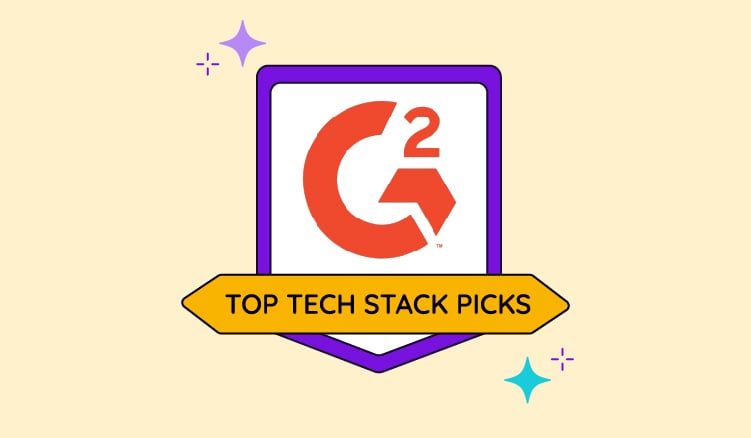
Keep the good stuff coming
Subscribe to our blog newsletter and get monthly content that helps you manage product data smarter.
No spam. Just real value.
Choosing the right software can make or break an online business. Without the right tech, you’re dooming yourself to countless hours of manual data entry, along with increased risks of data inaccuracies and inconsistencies (and the costly returns that come with them). There’s even the chance that you won’t be able to sell online at all, if customers can’t find or purchase your products—not exactly ideal.
But what types of software should you go for? There are some that are pretty essential for everyone, like software used to accept payments (I’ve heard it’s pretty hard to run an online business without a way for customers to pay you). In addition to the basics, though, there are a whole bunch of other options that may or may not be necessary for you, depending on your business and your situation. And once you’ve figured out the software categories that you need, how do you decide which company’s software to go for?
That’s why I’ve been checking out software review site G2, that has a reputation for providing impartial and accurate information about different software companies based on genuine customer reviews. This article’s all about eight of the most common types of software in an ecommerce tech stack, and G2’s top three companies for each one (as of December 2023). Let’s get started.
Product Information Management (PIM) software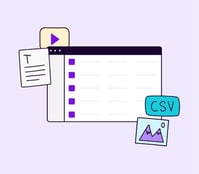
To kick things off, here’s my personal favorite ecommerce tech: Product information management or PIM software. This software is designed to help you get all of your product information in one place, make sure it’s all accurate and not missing anything, and then optimize it to get it into the best possible state for all your different sales channels (i.e. all the different places where you sell your products). PIM tools come with all sorts of specialized features to help you deal with your product data, automate as much of the selling process as possible, and improve collaboration between teams. On top of that, they often include digital asset management or DAM functionality as well (and who doesn’t love good DAM functionality?).
Key features of PIM software
- Centralized data management: PIM systems allow for the centralization of product information, making it easier to manage, update, and distribute this data across various channels and platforms. This feature helps guarantee consistency and accuracy of product data across your business.
- Data quality control: Quality control features in PIM software make it easier for businesses to maintain high standards for their product data. This includes tools for data validation, standardization, and avoiding duplication—making sure that the information is accurate, complete, and up-to-date.
- Multichannel integration: A key feature of PIM software is its ability to integrate with various sales and marketing channels. This lets you easily and consistently distribute product information across ecommerce platforms, retail outlets, catalogs, and other sales channels.
- Workflow and collaboration tools: PIM systems often come with workflow management and collaboration tools that allow different teams (like marketing, sales, and IT) to work together effectively. These tools help in managing the lifecycle of product information, from creation and editing to approval and publishing.
- Customization and scalability: Flexibility in terms of customization and scalability is important in PIM software. It should be able to adapt to the unique needs of a business, including custom attributes, different types of products, and scalability to handle growing product ranges and data volumes.
G2’s highest-rated PIM software
- Plytix
“Plytix is the most popular PIM on the market among small and medium businesses worldwide because of the user-friendly interface, low price point, and their whiteglove approach to onboarding and customer support.”
- Sales Layer PIM
“Sales Layer is a global-leading PIM (Product Information Management) platform that helps companies to automate complex B2B processes and connect their products to any enterprise sales platform or tool.”
- Catsy
“Catsy features pre-built integrations that you can turn on immediately, workflow automations that assist you in collaboration, and attribute tracking to meet your specific channel needs.“
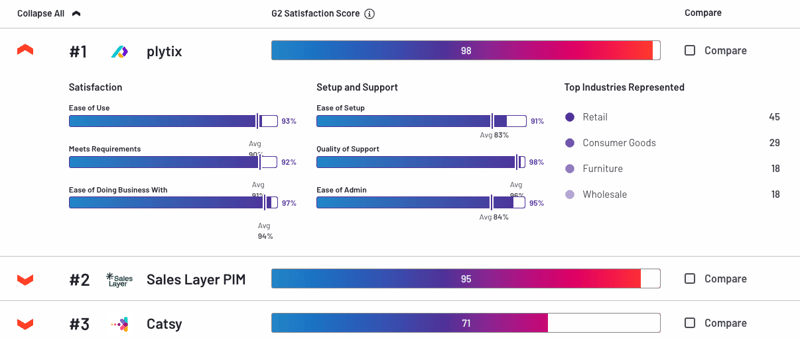
Digital Asset Management (DAM) software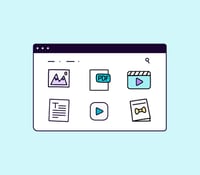
Serving as a centralized platform, DAM software is designed to help with the management, editing, and distribution of digital assets—it’s like a PIM tool, but focused specifically on images, videos, and audio files. It's designed to handle the complexities of multimedia content, so it normally includes advanced features for editing and conversion.
This tech is essential for businesses with advanced multimedia and content needs, and gives users an effective and efficient way to manage digital content. That being said, a lot of PIM tools also have DAM functionality included as a feature, and for businesses without super technical assets requirements that feature’s normally more than enough. For businesses using separate DAM software, though, it really comes into its own when they put it together with other key systems like marketing, content management tools, or again, PIM.
Key features of DAM software
- Advanced search and metadata management: DAM software comes with robust search capabilities, which allows users to quickly find digital assets using metadata, tags, and advanced search filters. This feature makes it much easier to quickly locate and use digital assets, saving a lot of time overall.
- Asset editing and conversion tools: Many DAM systems come with integrated tools for basic editing of images and videos. In addition, they should offer capabilities to convert files into various formats, letting users adapt digital content so they can use it across multiple platforms and mediums.
- Version control and rights management: This feature is essential for tracking the changes made to digital assets and managing the rights and permissions associated with each one. It makes sure that all modifications are recorded and that assets are used in compliance with legal and company standards.
- Integration with other systems: Quality DAM software should be able to integrate well with other business systems, including content management systems and marketing tools. This integration is vital for distributing digital assets in an efficient way, and making workflow processes run more smoothly as a result.
- Asset sharing and distribution: DAM systems are designed to simplify sharing and distribution of digital assets both inside and outside the organization. This feature includes control mechanisms for access and usage, making it easier for teams to collaborate and distribute content effectively while maintaining security and compliance.
G2’s highest-rated DAM software
- Air
- “Air is the Creative Operations System for marketing and creative teams. Find, organize, share, and collaborate on your images and videos.”
- Brandfolder
- “Brandfolder is a visually-elegant and user-friendly Digital Asset Management software that allows marketers and creatives across industries to maximize their brand management potential.”
- Bynder
- “Bynder is a digital asset management (DAM) platform that goes far beyond managing digital assets. [They] enable teams to conquer the chaos of proliferating content, touchpoints, and relationships in order to thrive.”
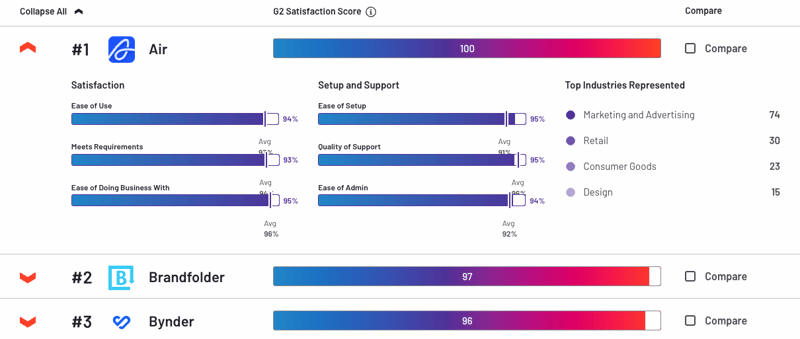
Product Lifecycle Management (PLM) software
Moving on to an equally crucial piece of the ecommerce tech stack puzzle: Product Lifecycle Management, or PLM software. PLM software is engineered to handle data related to product development and management throughout your product’s entire lifecycle, from the initial spark of an idea to the final phases of product retirement. It's all about bringing efficiency and coherence to the development process by sharing relevant data in an efficient way. It often integrates with other systems like ERP and PIM, which lets you form a connected system for managing all aspects of a product's lifecycle.
Key features of PLM software
- Product data management: This feature centralizes all product-related data, including designs, specifications, and documentation, within the PLM system. It ensures that all stakeholders have easy access to the most current and accurate information, which is crucial for effective product development and decision-making.
- Workflow management: PLM software manages and monitors the progression of a product's lifecycle, using workflow tools to track status and milestones. This feature helps coordinate the various stages of product development, making sure that each phase progresses when it should and with the right resources.
- Collaboration tools: PLM software provides tools for communication and collaboration between everyone involved in product development. This feature breaks down isolated data silos between different departments and external partners, allowing for a seamless exchange of ideas, feedback, and updates.
- Change management: This tool within the PLM software is designed to manage and track all changes in product design and development. Using it well means that every change made to the product is carefully logged, reviewed, and approved, which helps guarantee the integrity of the design process and that the product meets compliance standards.
- Quality management: Checking product quality and compliance with industry standards is a key function of PLM software. It integrates quality control processes throughout every stage of the product lifecycle, from initial design through to final production, guaranteeing that the final product meets all required quality benchmarks and regulatory requirements.
G2’s highest-rated PLM software
- OpenBOM
- “OpenBOM is a digital network-based PLM platform that manages product data and connects manufacturers and supply chain networks. OpenBOM manages Parts (Items), CAD files, Item Masters (Catalogs), Documents, Bill of Materials, Vendors, Production Planning, and Purchase Orders.”
- Teamcenter
- “Teamcenter® software is a modern, adaptable product lifecycle management (PLM) system that connects people and processes, across functional silos, with a digital thread for innovation.”
- Arena PLM & QMS
- “Arena, a PTC Business helps companies design, produce, and deliver innovative products quickly with [their] unified, cloud-native product lifecycle management (PLM) and quality management system (QMS) platform.”
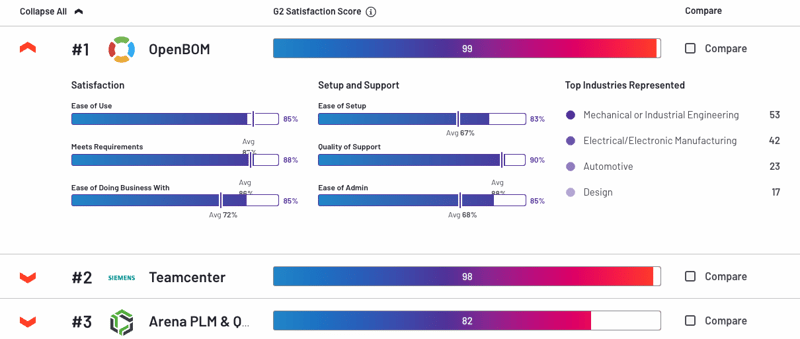
Enterprise Resource Planning (ERP) systems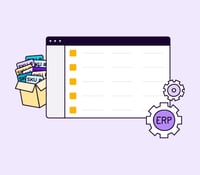
Now, let's delve into the world of Enterprise Resource Planning, or ERP systems. The technological glue that binds the various aspects of a company's operations together into a unified whole, these systems are designed to connect various different internal systems together—everything from finance and HR to supply chain management and customer relations.
An ERP system acts as a centralized hub for critical data, which can be accessed and used by different departments, which can help you maintain consistency and accuracy in information across your organization. This technology is essential for businesses looking to optimize their operations, improve resource management, and achieve a holistic, inclusive view of their internal processes.
Key features of ERP systems
- Financial management: This feature provides comprehensive tools for managing all aspects of accounting, financial reporting, and risk management. It helps businesses comply with accounting standards, make their financial processes more efficient, and gain insights into financial performance.
- Supply chain management: Managing supply chain operations, including procurement, inventory, and logistics, is a critical aspect of ERP systems. This feature aids in optimizing the flow of goods from suppliers to customers, improving inventory management, and generally making supply chain operations run smoothly.
- Human resources management: This function handles a variety of HR tasks, including recruitment, payroll processing, and performance evaluation. It simplifies HR processes, assists with employee management, and helps maintain an efficient workforce.
- Customer relationship management: Integrating sales, customer service, and marketing data, this feature of ERP systems helps businesses manage their interactions with customers. It aids in tracking sales leads, managing customer information, and improving customer service, which can improve customer relationships as a result.
- Analytics and reporting: ERP systems offer powerful data analysis and reporting capabilities, letting businesses make better, data-driven decisions. This includes generating detailed reports on various aspects of the business, providing insights into performance, and identifying areas for improvement.
G2’s highest-rated ERP systems
- NetSuite
- “As the world's #1 cloud ERP solution for more than 20 years, NetSuite has helped businesses gain the visibility, control, and agility to build and grow a successful business.“
- Sage Intacct
- “Sage Intacct is the flexible and scalable financial platform that delivers deep accounting capabilities to thousands of businesses across the world.”
- SAP s/4HANA Cloud
- “SAP S/4HANA Cloud is a modular cloud ERP software designed for every business need – powered by AI and analytics. SAP S/4HANA Cloud enables users to run mission-critical operations in real time from anywhere, introduce new business models in an industry, and expand globally.”
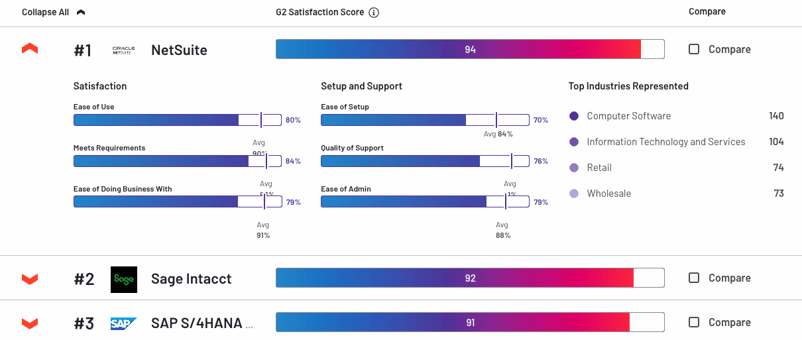
Ecommerce platforms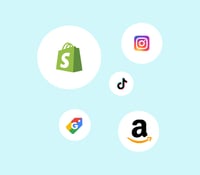
Ecommerce platforms (a.k.a. ecommerce CMS or webshop systems) are the engines that power online retail, offering a complete toolkit to help you set up, manage, and grow your online store. These platforms simplify the process of creating and customizing digital storefronts and let businesses provide a seamless shopping experience for customers.
Some typical ecommerce platform features would be shopping carts, payment processing, and inventory management. Having all these tools in one place gives businesses a single tool to handle everything from product listings to sales transactions—on a basic level at least. On top of that, ecommerce platforms often come equipped with marketing and SEO tools to help boost online visibility and attract customers.
Key features of ecommerce platforms
- Website and online store creation: This feature provides tools for building and customizing online stores, allowing businesses to create a professional and user-friendly online presence. It includes customizable templates, design options, and functionalities tailor-made for any aspiring ecommerce business.
- Shopping cart and checkout process: Managing the shopping experience and transaction process is crucial. This involves providing a smooth and intuitive shopping cart system, along with a secure and efficient checkout process that makes it as easy as possible for potential customers to become real customers.
- Payment gateway integration: This feature makes various payment options possible for customers, including credit cards, digital wallets, and other payment methods. It provides secure and seamless payment transactions, allowing for the different preferences of different online shoppers.
- SEO and marketing tools: Boosting the visibility and marketing capabilities of the online store is essential. This includes tools for search engine optimization, social media integration, email marketing, and other marketing strategies that drive traffic and sales.
- Order and inventory management: This involves managing inventory levels and fulfilling customer orders effectively. It includes features for tracking stock, automating order processing, and guaranteeing on-time delivery, which are key for keeping things running smoothly and maintaining customer satisfaction and loyalty.
G2’s highest-rated ecommerce platforms
- Shopify
- “Shopify is the leading cloud-based, multichannel commerce platform designed for small and medium-sized businesses. Merchants can use the software to design, set up, and manage their stores across multiple sales channels, including web, mobile, social media, marketplaces, brick-and-mortar locations, and pop-up shops.“
- Goflow
- “Goflow is a cloud-based SaaS platform that helps enterprise ecommerce companies easily integrate with leading marketplaces and manage their multichannel orders, shipping, inventory, listings, transfers, purchasing, and analytics from a single interface.”
- WooCommerce
- “WooCommerce is the most popular WordPress ecommerce plugin. And it's available for free. Packed full of features, perfectly integrated into your self-hosted WordPress website.”
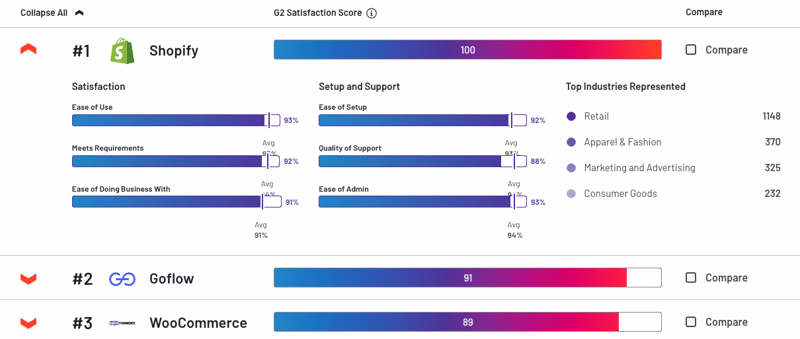
Multichannel retail software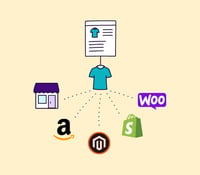
Multichannel retail software is a fantastically useful tool for businesses aiming to expand their presence across various sales channels. This software makes the process of selling products through multiple avenues a whole lot easier, whether you’re selling on online marketplaces, social media, and/or brick-and-mortar stores. It synchronizes and manages inventory, orders, and customer data across all these channels, maintaining consistency and efficiency (which is the goal for a lot of the software on this list, in case you hadn’t noticed).
Key features of multichannel retail software
- Channel integration: This feature involves the integration of various sales channels, including online marketplaces, social media platforms, and brick-and-mortar stores. It gets all sales avenues operating under a single system, which lets companies offer a cohesive and consistent retail experience across different selling platforms.
- Inventory synchronization: Keeping inventory data consistent across all channels is essential. This feature helps in maintaining accurate stock levels, regardless of where the sale is made, and preventing issues like over-selling and stock discrepancies.
- Order management: This involves managing orders from multiple channels within a centralized system. It simplifies the process of handling orders, from initial receipt through to fulfillment, no matter the sales channel, so that orders are processed accurately and efficiently.
- Customer data management: Collecting and managing customer data from different channels allows for a comprehensive, in-depth view of customer interactions. This feature means that customer information is organized and accessible, letting businesses create personalized customer service and targeted marketing strategies.
- Analytics and reporting: Providing insights into sales and customer behavior across various channels is vital. This feature offers detailed analytics and reporting capabilities, allowing businesses to understand sales trends, customer preferences, and overall performance across all channels, which helps with strategic decision-making and optimization of sales strategies.
G2’s highest-rated multichannel retail software:
- CedCommerce
- “CedCommerce is a leading ecommerce platform and marketplace integrator whose vision is to build secure, optimized, and scalable integration tools and technologies for online sellers to offer them multichannel capabilities.”
- DataFeedWatch by Cart.com
- “DataFeedWatch is a Feed Marketing solution that combines data transformation & optimization with help & advice. It empowers merchants and agencies to succeed on ecommerce channels.”
- Feedonomics
- “With its leading data feed management platform, Feedonomics helps brands and retailers optimize and list their product catalogs on hundreds of ecommerce shopping destinations around the world.”
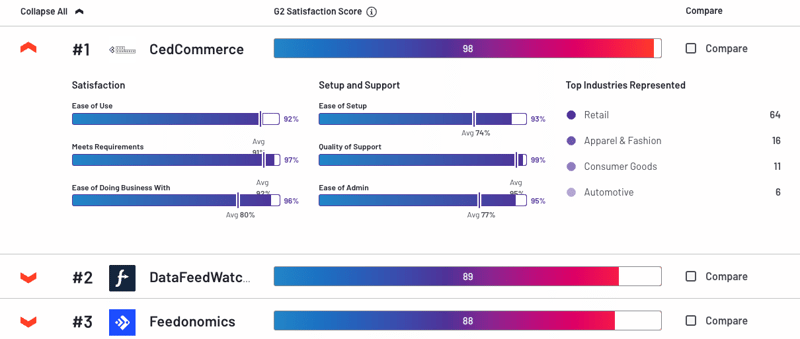
Payment processing software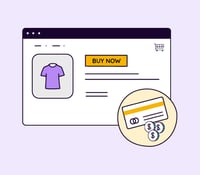
Payment processing software is a fundamental tool for any business involved in online transactions. This technology provides businesses and their customers with a way to efficiently and securely transfer funds, and is designed to handle various payment methods, from credit cards to digital wallets. In some cases it’s not just about giving customers a smooth checkout experience—it can also provide valuable analytics and reporting capabilities to help businesses understand their sales trends and manage their finances effectively.
Key features of payment processing software
- Secure payment processing: This feature focuses on the secure handling of customer payment information. It provides the highest level of security for all transactions, safeguarding sensitive data and maintaining customer trust. This includes implementing encryption and secure protocols to protect against data breaches.
- Multiple payment methods: The software supports a variety of payment methods, including credit cards, digital wallets, and bank transfers. This flexibility allows businesses to cater to all the different preferences of their customers, making payments easier and improving the customer experience.
- Fraud detection and prevention: This includes advanced security measures to detect and prevent fraudulent transactions. The software continuously monitors transactions for suspicious activities, using algorithms and verification processes to minimize the risk of fraud.
- Integration capabilities: The software is designed to integrate seamlessly with ecommerce platforms and accounting software. This integration guarantees a smooth transaction process, efficient data management, and consistency across various business systems.
- Reporting and reconciliation: Payment processing software provides detailed transaction reports and reconciliation tools. This feature helps businesses in tracking payments, managing finances, and maintaining accuracy in their financial records. It offers insights into transaction trends and financial health to help companies make strategic business decisions.
G2’s highest-rated payment processing software
- Amazon Pay for Business
- “Amazon Pay makes it simple for hundreds of millions of customers around the globe to pay for products and services using the information already stored in their Amazon accounts. It’s a familiar buying experience from a brand customers know and trust.”
- Paymerang
- “Paymerang provides a streamlined invoice and payment automation platform that brings Accounts Payable (AP) departments into the modern age. “
- Stripe Payments
- “Stripe’s Payments platform helps you accept credit cards, debit cards, and popular payment methods around the world. [Their] easy-to-use APIs, no-code payments options, and software solutions enable you to launch a company, experiment to find product-market fit, and grow and scale revenue quickly.”
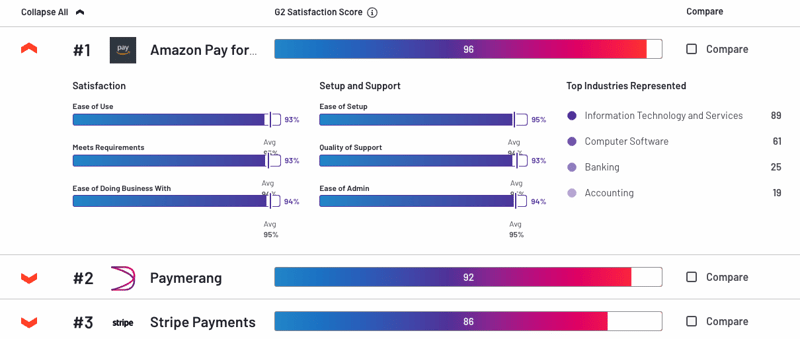
Inventory control software
Inventory control software comes in handy for businesses that want to manage their stock levels effectively and efficiently. It lets companies track their inventory in real-time, which helps with planning and decision-making, and integrates critical aspects of inventory management, such as monitoring stock levels, managing purchase and sales orders, and forecasting future inventory needs. Features like barcode scanning simplify the tracking and management of inventory items, and this software often also provides valuable analytics and reporting features, helping retailers better understand things like inventory performance, turnover rates, and potential stock shortages.
Key features of inventory control software
- Inventory tracking: Inventory control software provides real-time monitoring of stock levels. This feature is essential for maintaining an accurate and current overview of inventory, allowing businesses to efficiently manage stock and respond quickly to inventory changes.
- Order management: This aspect of inventory control software involves managing both purchase and sales orders. It simplifies the process from the initiation of orders to their fulfillment, and supports efficient and precise handling, which is crucial for maintaining customer satisfaction and inventory accuracy.
- Demand forecasting: The software includes tools for predicting future inventory requirements based on analysis of sales trends. By making use of historical data and market insights, it helps businesses anticipate customer demand, which leads to more effective inventory planning and less risk of stock shortages or surpluses.
- Barcode scanning: This feature uses barcode technology to simplify the tracking and management of inventory items. It increases the speed and accuracy of inventory control processes, significantly improving efficiency and reducing the likelihood of errors.
- Reporting and analytics: Inventory control software provides comprehensive insights into inventory performance and needs through detailed reporting and analytics. This functionality delivers critical data about inventory levels, turnover rates, and the status of orders, letting businesses make informed decisions and optimize their inventory management strategies.
G2’s highest-rated inventory control software
- Cin7 Core (formerly DEAR)
- “Cin7 Core, formally known as DEAR, is an app that makes enterprise-level inventory management, manufacturing, sales integration, reporting, and automation accessible to all businesses.”
- GMDH Streamline
- “Streamline best suits mid-sized businesses (manufacturers, distributors, and retailers worldwide) looking to optimize their inventory management with automated demand forecasting, replenishment execution, multi-location planning, seasonality, supplier management, and more.”
- EZOfficeInventory
- [Their] leading asset lifecycle management software enables you to create POs, schedule services and manage vendors effortlessly. Easy depreciation management and custom reports help you make well-informed business decisions.
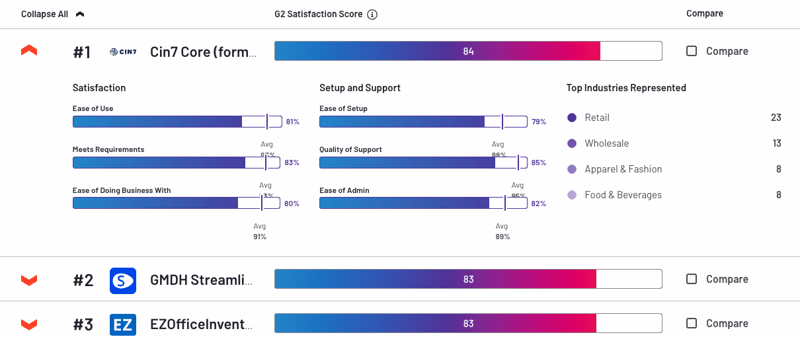
Final recommendations
Choosing the right ecommerce software is a critical decision for any online business. The landscape of ecommerce technology is vast and varied, with a massive number of tools available to optimize different aspects of your online selling process. From managing product information with PIM software to streamlining payment processes and controlling inventory, each type of software has its own unique role in improving the efficiency and effectiveness of your ecommerce operations—and the more information you have available about the different options, the better.
That’s why we’ve put together a downloadable ebook on this topic as well, for you to browse through at your leisure—it’s waiting for you just down below.
Frequently Asked Questions
- Product information management (PIM) software
- Digital asset management (DAM) software
- Product lifecycle management (PLM) software
- Enterprise resource planning (ERP) software
- Ecommerce platforms
- Multichannel retail software
- Payment processing software
- Inventory control software
Depending on the specific details and requirements of your company, you may find you could benefit from a few, some, or all of these software solutions.
- For product information management, Plytix, Sales Layer PIM, and Catsy are highly rated.
- For digital asset management, Air, Brandfolder, and Bynder are top choices.
- For product lifecycle management, OpenBOM, Teamcenter, and Arena PLM & QMS are recommended.
- In enterprise resource planning, NetSuite, Sage Intacct, and SAP s/4HANA Cloud are leading options.
- For e-commerce platforms, Shopify, Goflow, and WooCommerce are highly regarded.
- For multichannel retail, CedCommerce, DataFeedWatch by Cart.com, and Feedonomics are excellent choices.
- For payment processing, Amazon Pay for Business, Paymerang, and Stripe Payments are top-tier.
- For inventory control, Cin7 Core, GMDH Streamline, and EZOfficeInventory are recommended.
To find the best ecommerce software, consider your business size, industry, and specific needs. Research and compare different software options in categories relevant to your business, such as PIM, DAM, PLM, ERP, ecommerce platforms, multichannel retail software, payment processing, and inventory control. Look for reviews and ratings on software review sites like G2 to get impartial and accurate information based on genuine customer reviews. Consider the key features, ease of use, scalability, and integration capabilities of each software. It's also helpful to request demos or trial versions to evaluate the software's fit for your business.
According to G2, as of December 2023, Shopify is the leading ecommerce platform. Shopify is celebrated for its user-friendliness, versatility, and comprehensive set of features. It's designed for small and medium-sized businesses, allowing them to design, set up, and manage their stores across multiple sales channels, including web, mobile, social media, marketplaces, and physical locations. Shopify's flexibility and range of integrations make it a popular choice for many ecommerce businesses.

What if your product data actually worked for you?
We’ll show you how Plytix helps you stop fixing data—and start using it.
Related posts
Keep the good stuff coming
Subscribe to our blog newsletter and get monthly content that helps you manage product data smarter.
No spam. Just real value.
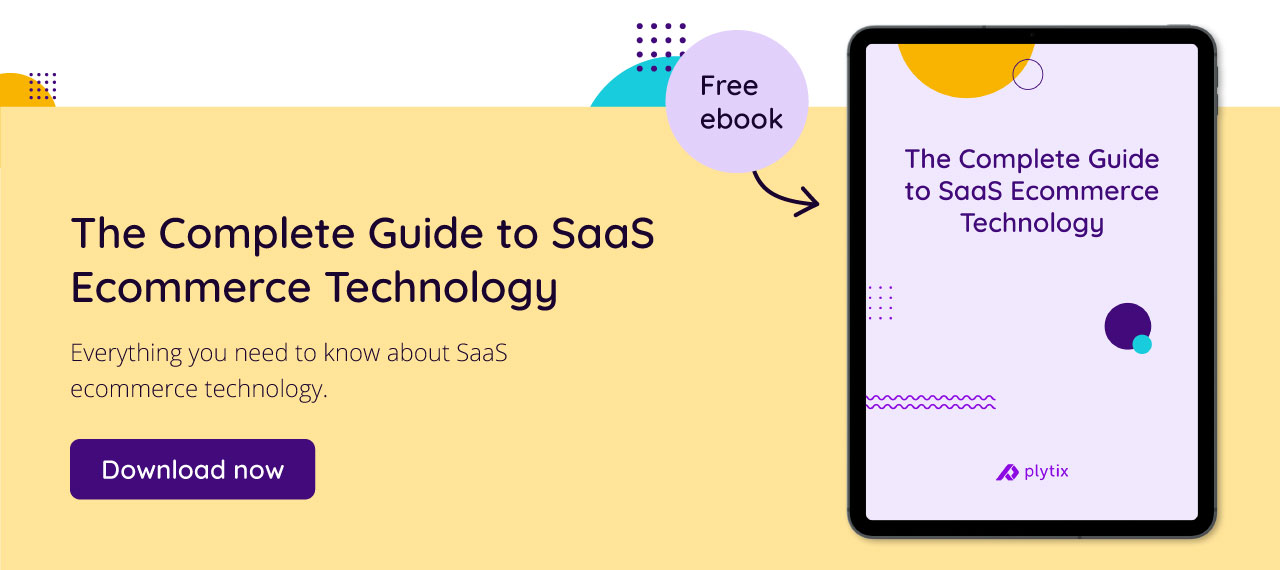





Think others should see this?
Go ahead and share it.